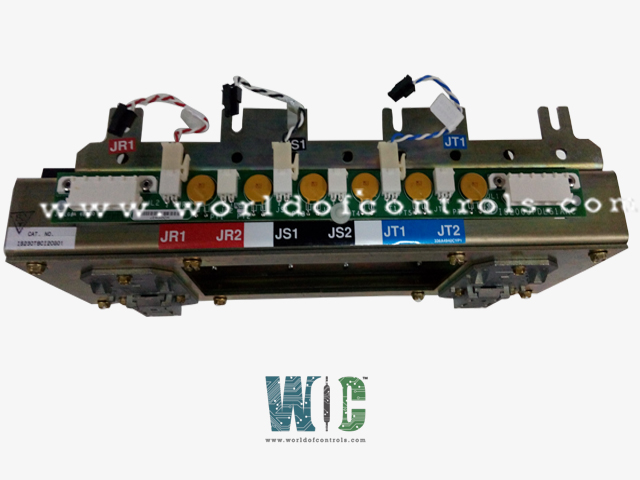SPECIFICATIONS
Part No.: IS230TBCIH3C
Manufacturer: General Electric
Number of channels: 24
Input filter: Hardware filter, 4 ms
Temperature rating: 0 to 60oC
Technology: Surface-mount
Size: 33.02 cm high x 10.16 cm wide
Availability: In Stock
Power consumption: 20.6 watts
Temperature rating: 0 to 60 oC
Country of Manufacture: United States (USA)
Series: Mark VI
Functional Description
IS230TBCIH3C is a Simplex Contact Input Module developed by GE. It is a part of the Mark VI control system. To facilitate convenient integration, the TBCI connects to the VME rack using cables with molded plugs. These cables establish a reliable link between the terminal board and the VCCC or VCRC board, ensuring efficient communication and control. In 48 V dc applications, the Contact Input with Group Isolation terminal board features two distinct current draw characteristics for its circuits. The first 21 circuits draw 2.5 mA each, while the last three circuits draw 10 mA each. These specific current draw values are carefully designed to ensure efficient and precise operation of the contact inputs. The board can efficiently manage a considerable number of contact inputs while maintaining optimal power usage and performance.
Module Operation
- The Contact Input with Group Isolation terminal board incorporates advanced filtering mechanisms that effectively mitigate high-frequency noise and surge on each input, ensuring reliable and accurate signal processing. Near the point of signal entry, the filters act as a protective shield, minimizing the impact of external disturbances on the contact inputs.
- It employs lower voltages as specified in the provided table. These versions are tailored to meet the requirements of specific applications, allowing for greater versatility in power supply configurations.
- The discrete input voltage signals, derived from the dry contact inputs, are then directed to the I/O processor. Optical isolators, providing group isolation, ensure complete electrical isolation between the input signals and the system controller. This isolation safeguards the system from potential ground loops and interference, enhancing the overall reliability and safety of the control system.
- The reference voltage utilized in the isolation circuits sets a transition threshold equal to 50% of the applied floating power supply voltage. This precise threshold determination ensures accurate signal detection and allows for smooth signal transitions.
- Moreover, the tracking of the signals is clamped to maintain a minimum level of 13% of the nominal rated supply voltage. This clamping mechanism ensures that all contact inputs indicate an open state when the voltage dips below this level. By doing so, the terminal board provides consistent and reliable open indications, even during voltage fluctuations or temporary power disruptions.
Wiring
- The 24 dry contact inputs are an essential part of the setup, and they are connected directly to two I/O terminal blocks that are securely mounted on the terminal board. To ensure stability and easy maintenance, these blocks are fastened in place using two screws. This design allows for the convenient unplugging of the terminal blocks from the board when maintenance or adjustments are necessary.
- Each of these terminal blocks is equipped with 24 terminals, specifically designed to accommodate wires of up to #12 American Wire Gauge (AWG) size. This feature ensures that a wide range of wire sizes can be connected to the terminal blocks, providing flexibility in wiring configurations.
- Additionally, for enhanced safety and effective grounding, a shield terminal strip is positioned adjacent to each terminal block. This strip serves as a secure connection point to chassis ground, ensuring that any unwanted electrical interference or potential surges are safely routed to the ground, preventing damage to the system and maintaining signal integrity.
Cabling connections
- The specific connectors and cables used are contingent upon the system's design, whether it's a simplex or a TMR (Triple Modular Redundancy) system.
- In a simplex system configuration, connector JR1 is the designated connector for establishing crucial connections. This connector serves as the interface through which various cables and I/O packs are plugged in, effectively creating the link between the Mark VI or Mark VIe system and the associated peripherals or devices. This streamlined approach is suitable for situations where redundancy is not a primary concern, and a single, efficient connection suffices.
- Conversely, in a TMR system, which is known for its high level of redundancy and fault tolerance, all three connectors come into play. These connectors are strategically employed to establish multiple, parallel connections, enhancing the system's resilience against failures or faults. This robust approach ensures that even if one of the connectors experiences an issue, the system can continue to operate smoothly without significant disruptions.
- Furthermore, the choice of cables or I/O packs to be plugged in is contingent on not only the system type (Mark VI or Mark VIe) but also the desired level of redundancy. Different cables and I/O packs may be required for configurations with varying degrees of redundancy. These components are crucial in ensuring that the system functions reliably under diverse conditions, adapting to the specific needs and requirements of the installation.
World of Controls has the most comprehensive collection of GE Mark VI components. Please contact WOC as soon as possible if you require any extra information.
Frequently Asked Questions
What is IS230TBCIH3C?
It is a Simplex Contact Input Module developed by GE
Can the board accommodate a wide range of contact input devices?
Yes, the board is designed to handle various types of contact input devices. With its 24 dry contact input connections and flexible terminal block capacity, it can integrate with a diverse range of external devices and sensors.
Does the terminal board offer redundancy options for contact inputs?
The terminal board's design supports redundancy and fault tolerance options when combined with appropriate control systems, providing additional reliability for critical contact input applications.
Can the it be used in safety-critical applications?
Yes, it's reliable and secure design makes it suitable for safety-critical applications where precise and dependable contact input handling is essential.
